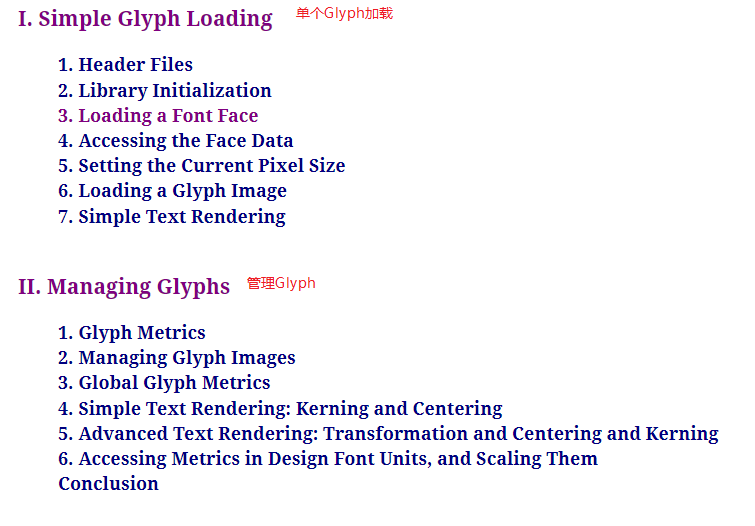freetype矢量字体 —— 例程1源码解析
例程源码exmaple1
本地源码路径freetype-2.10.2/docs/tutorial/example1.c
or 官网地址:https://freetype.org/freetype2/docs/tutorial/example1.c
例程主要工作:在控制台打印一行字符串对应的用freetype处理后用于显示的bitmap,第一个字符左上角坐标(300, 200),模拟的LCD区域大小WIDTH x HEIGHT = 640 x 480。
其中,image[][]数组用于存放模拟lcd的像素值,相当于lcd的Framebuffer。
注意:如果要在LCD上显示文字内容, 就将draw_bitmap中的image[j][i]赋值语句, 替换为写LCD的Framebuffer缓冲区,而且无需调用show_image。
每行代码解析,见下方代码注释:
/* example1.c */
/* */
/* This small program shows how to print a rotated string with the */
/* FreeType 2 library. */
#include <stdio.h>
#include <string.h>
#include <math.h>
// 1. 包含freetype头文件
#include <ft2build.h>
#include FT_FREETYPE_H // for freetype 基础API
// 用于显示的目标LCD区域大小
#define WIDTH 640
#define HEIGHT 480
/* origin is the upper left corner */
unsigned char image[HEIGHT][WIDTH];
/* Replace this function with something useful. */
// 如果要在LCD上显示文字内容, 就将image[j][i]赋值语句, 替换为写LCD的Framebuffer缓冲区
/**
以LCD坐标(x, y)为起始位置, 显示bitmap
@param bitmap 要绘制的bitmap, 通常包含在slot中
@param x 要绘制的bitmap的起始横坐标
@param y 要绘制的bitmap的起始纵坐标
@details 坐标采用的LCD坐标系
*/
void
draw_bitmap( FT_Bitmap* bitmap, FT_Int x, FT_Int y)
{
FT_Int i, j, p, q;
FT_Int x_max = x + bitmap->width;
FT_Int y_max = y + bitmap->rows;
/* for simplicity, we assume that `bitmap->pixel_mode' */
/* is `FT_PIXEL_MODE_GRAY' (i.e., not a bitmap font) */
for ( i = x, p = 0; i < x_max; i++, p++ ) // x 轴方向
{
for ( j = y, q = 0; j < y_max; j++, q++ ) // y轴方向
{
if ( i < 0 || j < 0 ||
i >= WIDTH || j >= HEIGHT )
continue;
// 将bitmap中1写入image矩阵
// LCD的y轴对应image的行数, x轴对应列数
image[j][i] |= bitmap->buffer[q * bitmap->width + p];
}
}
}
/**
串口打印image内容, 即一行字符串对应的bitmap内容
*/
void
show_image( void )
{
int i, j;
for ( i = 0; i < HEIGHT; i++ )
{
for ( j = 0; j < WIDTH; j++ )
putchar( image[i][j] == 0 ? ' '
: image[i][j] < 128 ? '+'
: '*' );
putchar( '\n' );
}
}
int
main( int argc,
char** argv )
{
FT_Library library; // freetype库
FT_Face face; // face对象, 包含了字体信息
FT_GlyphSlot slot; // 插槽slot, 保存了处理后的bitmap
FT_Matrix matrix; /* transformation matrix */
FT_Vector pen; /* untransformed origin */
FT_Error error; // 错误码
char* filename; // 字体文件
char* text; // 要显示的一行字符串
double angle; // 要旋转的角度
int target_height; // 用于显示的目标区域高度, 通常为LCD高度
int n, num_chars;
if ( argc != 3 )
{
fprintf ( stderr, "usage: %s font sample-text\n", argv[0] );
exit( 1 );
}
// 字体文件名
filename = argv[1]; /* first argument */
// 要显示的文本内容
text = argv[2]; /* second argument */
// 要显示的文本长度
num_chars = strlen( text );
// 旋转角度, 单位为弧度
angle = ( 25.0 / 360 ) * 3.14159 * 2; /* use 25 degrees */
target_height = HEIGHT;
// 2. 初始化freetype库
error = FT_Init_FreeType( &library ); /* initialize library */
/* error handling omitted */
// 3. 加载/打开字体face, 会创建一个face对象
error = FT_New_Face( library, filename, 0, &face );/* create face object */
/* error handling omitted */
// 4. 设置字体大小, 单位pt
/* use 50pt at 100dpi */
error = FT_Set_Char_Size( face, 50 * 64, 0,
100, 0 ); /* set character size */
/* error handling omitted */
// 5. (略)选择charmap: FT_Select_Charmap
/* cmap selection omitted; */
/* for simplicity we assume that the font contains a Unicode cmap */
slot = face->glyph; // 获取glyph slot, 存放了glyph image
// 设置旋转矩阵
/* set up matrix */
matrix.xx = (FT_Fixed)( cos( angle ) * 0x10000L );
matrix.xy = (FT_Fixed)(-sin( angle ) * 0x10000L );
matrix.yx = (FT_Fixed)( sin( angle ) * 0x10000L );
matrix.yy = (FT_Fixed)( cos( angle ) * 0x10000L );
/* 反推出第一个字符的origin */
// 设置pen, 即绘制字体的起始位置, 笛卡尔坐标
// 要显示的第一个字符左上角LCD坐标(300,200), 转换为笛卡尔坐标(300, target_height - 200)
// *64是因为FT_Set_Transform要求坐标单位是1/64像素
/* the pen position in 26.6 cartesian space coordinates; */
/* start at (300,200) relative to the upper left corner */
pen.x = 300 * 64;
pen.y = ( target_height - 200 ) * 64;
// 循环显示字符串的所有字符
// 按行显示
for ( n = 0; n < num_chars; n++ )
{
// 9. 移动/旋转glyph image
/* set transformation */
FT_Set_Transform( face, &matrix, &pen );
// 5/6/7. 加载glyph image到slot, 可以直接得到bitmap, 存放在slot中
/* load glyph image into the slot (erase previous one) */
error = FT_Load_Char( face, text[n], FT_LOAD_RENDER );
if ( error )
continue; /* ignore errors */
// 绘制每个字符的bitmap
// 字符外框左上角坐标(bitmap_left, bitmap_top), 转换为LCD坐标(bitmap_left, target_height - bitmap_top)
/* now, draw to our target surface (convert position) */
draw_bitmap( &slot->bitmap,
slot->bitmap_left,
target_height - slot->bitmap_top );
// 计算下一个字体的起始位置origin
/* increment pen position */
pen.x += slot->advance.x;
pen.y += slot->advance.y;
}
show_image(); // 控制台打印bitmap对应的image数组, 如果要在LCD显示, 就应该写framebuffer
FT_Done_Face ( face ); // 释放指定face对象及其子slots和尺寸, 与FT_New_Face配对
FT_Done_FreeType( library ); // 释放字体文件缓存, 与FT_Init_FreeType配对
return 0;
}
/* EOF */
注:例程中,第一个字符的左上角位置是直接给定的,并没有按整行字符串的外框来调整。
小结
freetype显示字体流程
使用freetype绘制一行字符通用流程:
1)包含freetype头文件;
2)初始化freetype库:FT_Init_FreeType;
3)加载字体文件,创建face对象:FT_New_Face;
4)设置字体大小:FT_Set_Char_Size(单位pt)或FT_Set_Pixel_Size(单位pixel);
5)(可选)设置charmap(非默认编码时选用): FT_Select_Charmap;
6)根据编码值charcode寻找glyph_index: FT_Get_Char_Index;
7)根据glyph_index取出glyph: FT_Load_Glyph;
8)将glyph image转换为bitmap: FT_Render_Glyph
9)移动或旋转字符origin: FT_Set_Transform,坐标单位要求1/64像素;
10)显示bitmap:调用自定义draw_bitmap
步骤6,7,8 可以用一个函数替代FT_Load_Char(face, charcode, FT_LOAD_RENDER),直接得到glyph对应bitmap。
参考下图描述:

截取自 https://freetype.org/freetype2/docs/tutorial/index.html
LCD与笛卡尔坐标系转换
LCD显示使用LCD坐标系,freetype库使用笛卡尔坐标系。注意不同坐标系下的坐标转换。
已知LCD区域,通常是LCD屏幕大小(H, V)(宽、高)。那么,LCD坐标系下的(x, y),对应笛卡尔坐标系下(x, V - y)
本文作者:明明1109
本文链接:https://www.cnblogs.com/fortunely/p/16655523.html
版权声明:本作品采用知识共享署名-非商业性使用-禁止演绎 2.5 中国大陆许可协议进行许可。




【推荐】国内首个AI IDE,深度理解中文开发场景,立即下载体验Trae
【推荐】编程新体验,更懂你的AI,立即体验豆包MarsCode编程助手
【推荐】抖音旗下AI助手豆包,你的智能百科全书,全免费不限次数
【推荐】轻量又高性能的 SSH 工具 IShell:AI 加持,快人一步
· 无需6万激活码!GitHub神秘组织3小时极速复刻Manus,手把手教你使用OpenManus搭建本
· Manus爆火,是硬核还是营销?
· 终于写完轮子一部分:tcp代理 了,记录一下
· 别再用vector<bool>了!Google高级工程师:这可能是STL最大的设计失误
· 单元测试从入门到精通
2021-09-04 Linux Posix信号量、System V信号量,生产者与消费者问题应用